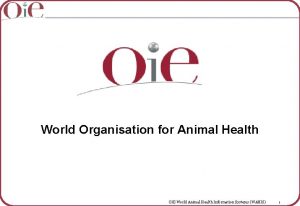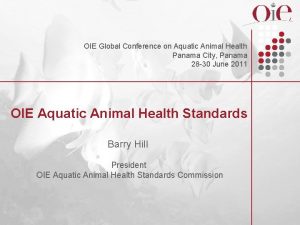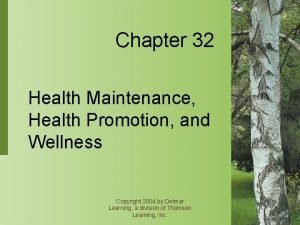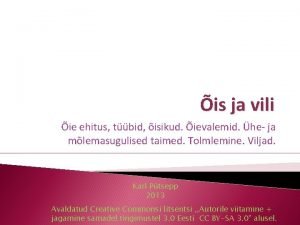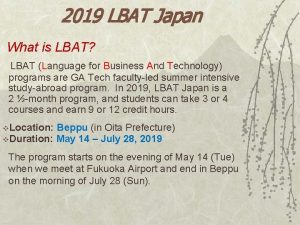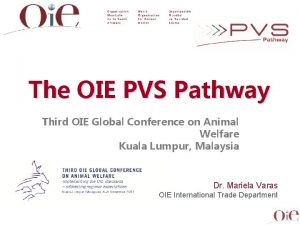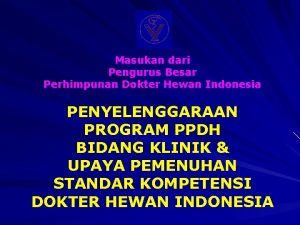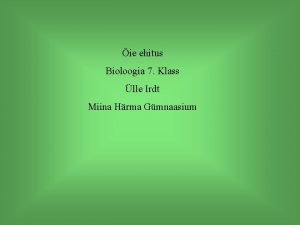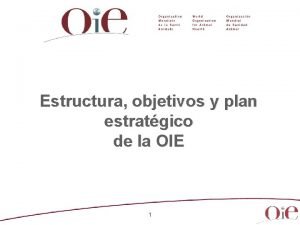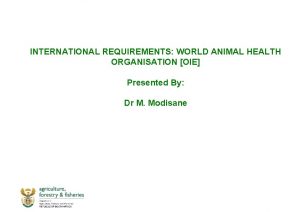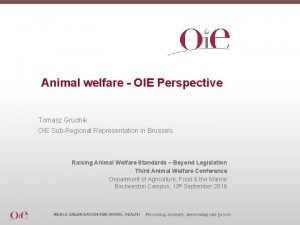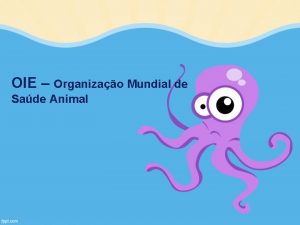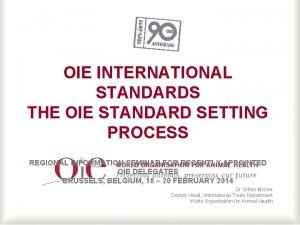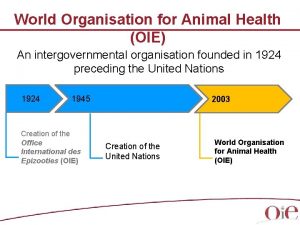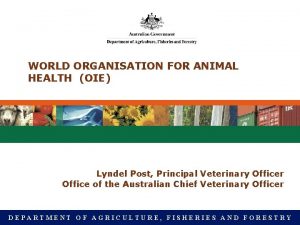World Organization for Animal Health OIE and Animal











- Slides: 11

World Organization for Animal Health (OIE) and Animal Welfare Presentation to the National Farm Animal Care Council May 13, 2010

Presentation Overview v. Animal Welfare and the OIE v. International trade context v. Animal Welfare Working Group’s work plan v. How can Canada influence the development of OIE animal welfare standards?

Animal Welfare and the OIE v. Member Countries requested the OIE to be the lead in establishing standards for animal welfare to ensure transparency, objectivity and science-base decision making v. In 2002, the Working Group on Animal established Welfare was vto promote animal welfare through a approach science-based 51 29 13 51 31

Animal Welfare and the OIE v. Working group members: v Dr. David Bayvel (NZ) - Chair, v Prof. David Fraser (CAN), v Dr. Andrea Gavinelli (EU), v Prof. Tore Hastein (Norway), v Dr. Marosi Molomo (Lesotho), v Dr. Sira Rahman (India), v Dr. Hassan Aidaros (Egypt), Representative of the 5 geographic regions of the OIE membership v. In addition: v Dr. David Wilkins (WSPA-UK) v Representative of International Federation of Animal Producers

Animal Welfare and the OIE v. Considerations in developing animal welfare standards: v 72% of Member Countries are developing and/or in transition countries v Diverse views and paradigms: animal cruelty vs. animal welfare (continuous improvement) vs. ethical acceptability v Farming without housing is the norm v The link between animal health and welfare needs to be stressed v. Complex area – economic, cultural, political dimensions, in addition to a large body of scientific information v Publication emphasize different criteria – freedom from pain and distress, maintenance of basic health, ability to live in a natural manner v Criteria: to be science based but there are varying interpretations

Animal Welfare and the OIE v. Definition of Animal Welfare v Context bien-être vs. bien traitance v Revisions, commentary offered by OIE Members v Adopted at the 76 th GS v. Reflection v 175 Members – diverse opinions and views v At the end of the day, use the principles outlined in Chapter 7. 1 Animal welfare means how an animal is coping with the conditions in which it lives. An animal is in a good state of welfare if (as indicated by scientific evidence) it is healthy, comfortable, well nourished, safe, able to express innate behaviour, and if it is not suffering from unpleasant states such as pain, fear, and distress. Good animal welfare requires disease prevention and veterinary treatment, appropriate shelter, management, nutrition, humane handling and humane slaughter/killing. Animal welfare refers to the state of the animal; the treatment that an animal receives is covered by other terms such as animal care, animal husbandry, and humane treatment.

International trade context v. Link with international standards? v. Terminology: standards, guidelines and recommendations v Implementation of international standards – Canadian context v Cabinet Directive on Streamlining Regulations v. Animal Welfare and the WTO SPS Agreement v. Bilateral relations – Canada – EU Vet Agreement v. Canada – EU Free Trade Agreement

Animal Welfare Work Plan Standards developed to date: v. Transportation: air, land sea; v. Slaughter food production and disease control In development or to be adopted: v. Control of stray dogs; v. Production systems: beef cattle and broilers; v. Laboratory animals; v. Aquatic Animals

Animal Welfare Workplan v. Ad hoc group on laboratory animal welfare formed in 2007 v September 2007 paper to scope out a strategy for lab animal welfare v Discussions started with the International Council of Laboratory Animal Science started in 2006 v OIE and ICLAS signed a cooperation agreement in May 2008 v Draft text March 2009 – Dr. Gilles Demers on the ad hoc group v. New chapter – not part of the Code per se, but will be placed on OIE website for reference v. Future directions v Transporting lab animals v Discussion paper: http: //www. oie. int/eng/bien_etre/en_introduction. htm

How can Canada influence the development of AW standards? v. Internationally – work closely with like minded countries such as NZ, US and Australia to identify areas where we can support each other. v. More active engagement with the EU v. Stakeholders and experts v How can we work together to ensure Canadian perspectives are taken into account? v Canada has been a significant player, comments are generally well-received v Efforts undertaken by NFACC and CCAC with respect to AW, are very much appreciated.

Thank you for your attention! Questions, comments, concerns?
